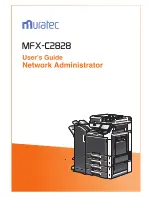
B.2. Selecting the Right Paper
B-5
Moisture Content
Moisture content is defined as the percent ratio of moisture to the dry mass of the paper.
Moisture can affect the paper's appearance, feedability, curl, electrostatic properties, and
toner fusing characteristics.
The moisture content of the paper varies with the relative humidity in the room. When the
relative humidity is high and the paper absorbs moisture, the paper edges expand, becom-
ing wavy in appearance. When the relative humidity is low and the paper loses moisture,
the edges shrink and tighten, and print contrast may suffer.
Wavy or tight edges can cause misfeeding and alignment anomalies. The moisture content
of the paper should be 4% to 6%.
To ensure the proper moisture content it is important to store the paper in a controlled envi-
ronment. Some tips on moisture control are:
❒
Store paper in a cool, dry location.
❒
Keep the paper in its wrapping as long as possible. Rewrap paper that is not in use.
❒
Store paper in its original carton. Place a pallet etc. under the carton to separate it from the
floor.
❒
After removing paper from storage, let it stand in the same room as the printer for 48 hours
before use.
❒
Avoid leaving paper where it is exposed to heat, sunlight, or damp.
Other Paper Properties
Porosity:
Refers to the density of the paper structure; that is, to how openly or compactly
the fibers are bonded.
Stiffness:
Limp paper can buckle inside the printer, while paper that is too stiff may bind.
Either way the result is a paper jam.
Curl:
Most paper has a natural tendency to curl in one direction. The paper should be loaded
so that the natural curl is downward, to counteract the upward curl imparted by the printer.
Printed sheets will then come out flat. Most paper also has a top and bottom surface. Load-
ing instructions are usually given on the paper package.
Electrostatic properties:
During the printing process the paper is electrostatically charged
to attract the toner. The paper must be able to release this charge so that printed sheets do
not cling together in the output tray.
Whiteness:
The contrast of the printed page depends on the whiteness of the paper. Whiter
paper provides a sharper, brighter appearance.
Quality control:
Uneven sheet size, corners that are not square, ragged edges, welded
(uncut) sheets, and crushed edges and corners can cause the printer to malfunction in var-
ious ways. A quality paper supplier should take considerable care to ensure that these prob-
lems do not occur.
Packaging:
Paper should be packed in a sturdy carton to protect it from damage during
transport. Quality paper obtained from a reputable supplier is usually properly packaged.
Содержание FS-6300
Страница 1: ...Table of Contents FS 6900 User s Manual Kyocera Laser Printer...
Страница 65: ...2 2 Operating Procedures 2 11 Sample Status Page 2 3 7 8 9 1 4 5 6...
Страница 103: ...3 2 List of Fonts 3 4 KPDL Fonts 1...
Страница 104: ...3 2 List of Fonts 3 5 KPDL Fonts 2...
















































